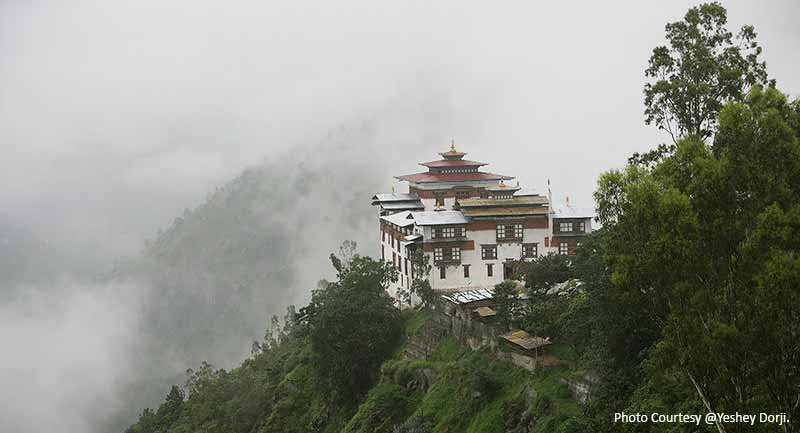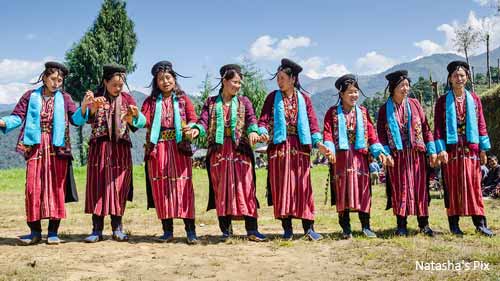Mongar / Lhuentse / Trashigang.
Making up the eastern part of Bhutan, these four districts (Mongar, Lhuentse, Trashigang & Trashi Yangtse), boasts the most diverse elevations and climatic zones. From lush sub-tropical forests to extreme alpines and mountains that form the natural formidable border, the east is a must visit. Here, rivers teem with mahseer, tigers roam the rich forests and the black necked cranes roost in highest climes. Trashigang and Lhuentse have spectacular dzongs replete with ancient history. The people of the east are also distinct in their way of life and culture.

Trashigang dzong in eastern Bhutan.
The monuments & tourist attractions in eastern Bhutan.
1. Trashigang dzong.
This dzong was constructed in 1659 by the Trongsa penlop, Chogyal Minjur Tempa on the command of Shabdrung Ngawang Namgyal. It is located on a stiff cliff and overlooks Drangme chu and Gamri chu below. It is the biggest dzong in eastern Bhutan and was built to defend against the Tibetan forces. The dzong was further expanded by Gyaltse Tenzin Rabgye between 1680 and 1694. The annual 4-day Trashigang festival in held here in late November – December. Trashigang is 466 Km away from Thimphu and 255 Km away from Bumthang on the way to Samdrup Jongkhar.
2. Merak & Sakten village:
The beautiful villages of Merak and Sakten fall under Trashigang district that borders state of Arunachal Pradesh in India. The people of Merak and Sakten are believed to be have descended from Tshona in South Tibet. They lead a semi nomadic lifestyle rearing yaks and sheeps, trade in butter and cheese in the near-by Tashigang market. Sakten falls under wild life sanctuary and is believed to be the home of Migoi or Abominable Snowman – the legendary Yeti. The people of these villages also wear a very unique dress made from woven yak / sheep hairs.

The nomadic people of Merak & Sakten (The Brokpas).
3. Lhuentse dzong – 60 Km from Mongar:
Lhuentse district (Dzongkhag) is one of the less visited districts in Bhutan and the ancestral home of Wangchuck dynasty. The dzong is situated in the fertile valley of Kuri chu and was originally built as a monastery by Kuenga Wangpo, son of Pema Lingpa in 1543. Later in 1654, the Trongsa Penlop, Chogyal Minjur Tempa built a formal dzong after winning a battle and named it Lhuentse Rinchentse. Lhuentse is 60 km away from Mongar town.
The earth quake of 21st September 2009 that hit eastern Bhutan caused a major damage to the dzong and many other temples in the region.
4. Weaving in Khoma village:
Khoma village near the Lhuentse dzong is very famous in weaving. The women folks of every household weave various types of textiles and bamboo products with intricate designs. These unique weaving practices involve basket-making, embroidery and brocade dress (Kushu Thara). The handloom products of Lhuentse is said to be best in the country.
5. Tallest statue of Guru Rinpoche at Takila (Lhuentse):
The statue of Guru Rinpoche at Takila mountain slope overlooks the beautiful valley of Tangmachu. It stands at 173 feet and is the largest statue of Guru Rinpoche in the world. The statue is built by the Late Ven. Khenpo Karpo Rinpoche. There is an old monastery at the site of the statue that belongs to Tangmachu community.
6. Mongar dzong:
This is a fairly new dzong built in 1930 compared to other dzongs in Bhutan. Like all other dzongs, no nails were used in the construction of this dzong. It is located on a gentle slope above the main Mongar market. The dzong also hosts a monastic school.
7. Chorten Kora in Trashi Yangtse:
One of the most important stupa in eastern Bhutan is Chorten Kora built in the 18th century by Lama Ngawang Lodro. The stupa is built in the style of Boudanath temple in Kathmandu. It took 12 years to construct this temple and was consecrated by Je Yonten Thaye.
The people believe that a Dakini princess from neighboring Arunachal Pradesh in India has entombed herself in when the temple was constructed. A popular Bhutanese film “Chorten Kora” is based on this story.
